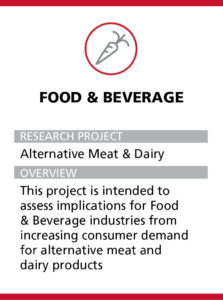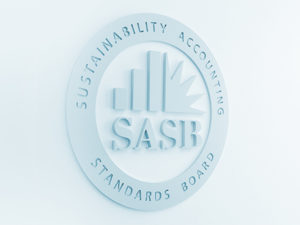
This month, we check in with Analyst Devon Bonney, SASB’s Sector Lead for the Food & Beverage sector.
What were some of the key questions you were trying to answer with market consultation?
It probably goes without saying that over the past few years, alternative meat and dairy products have really caught on. If you walk into almost any coffee shop today, you have your choice of traditional cow’s milk, soy milk, almond milk, oat milk, and more. Grocery store freezers display plant-based burgers alongside beef patties and other traditional meat products. Some restaurants are even adding entire plant-based sections to their menus. Consumer demand seems to be motivated by a range of different things, but a big one is environmental impact. Traditional meat and dairy products are highly resource-intensive to produce and have a significant environmental footprint. Life-cycle assessments show that plant-based meats, as an example, require 72 to 99 percent less water to produce, generate 30 to 90 percent less greenhouse gas emissions, and result in 51 to 91 percent less nutrient pollution in water systems. So, there’s at least the potential here for companies to capture market share and reduce their environmental impact at the same time.
But that’s the issue. Even as these products seem to be popping up nearly everywhere, it’s still an open question how much of market exists for them and what shape it will take. So, from a big-picture perspective, we’ve been trying to develop a better understanding of how this trend is playing out in different food and beverage industries. How significant is the demand? How are different companies—or entire industries—responding? What are the financial implications? And do investors care?
And what did you learn?
Well, we talked to more than 20 different companies and got input from more than a dozen buy-side and sell-side investors, and I guess I would say there are two main things we learned. First, companies and investors generally agree that the shift toward alternative products is not just a fad—it’s here to stay. Second, we learned that the implications of this trend vary considerably from one industry to the next.
So, on the first point, we heard from both companies and investors that the market for alternative meat and dairy is likely to continue growing. For example, one estimate is that plant-based meats will represent 10 percent of the global protein market—or about US$140 billion—by the end of the decade. To put that in perspective, it’s roughly equal to the size of the skincare market today. In other words, it’s quite large.
But, again, to the second point, it won’t impact every industry in the same way or to the same degree. We learned, for example, that incumbent Meat, Poultry & Dairy companies are already pursuing strategies to remain competitive. Primarily, that’s happening through R&D expenditures and targeted acquisitions, but some companies are also exploring how they can reduce the environmental footprint of traditional products through innovative practices. Meanwhile, food retailers are mostly focused on how they can reduce the environmental impact of their product offerings and supply chains, especially with respect to their private-label products. But, the issue is also top-of-mind from a financial perspective, because they’ve seen a significant increase in sales of alternative products during the pandemic, due to lower price points and meat shortages.
At the other end of the spectrum, we found little or no evidence that companies in the restaurant and beverage industries are facing significant financial ramifications related to this trend. So, it varies considerably across the sector, which means addressing the issue will be nuanced.
What are the next steps for SASB based on this feedback?
We’ll be digging deeper, but with more focus. During the recent Standards Board meeting, the Board expressed interest in developing a better understanding of the potential financial implications for key industries, including Meat, Poultry & Dairy, Food Retailers & Distributors, and Processed Foods. So, we’ll explore each one in more detail through additional research and consultation with companies and investors in the coming weeks and months.
Of course, the ultimate goal will be to determine whether standard-setting is warranted and, if so, how we might begin to think about the best path forward. For example, could we capture the risks and opportunities related to this issue by modifying the topics or metrics that currently exist in each industry standard? Or would it be more effective to propose a new topic—for instance, something related to a firm’s business model and innovation capacity?
So, there’s plenty more to do. But, whatever the outcome, market input will continue to be invaluable to our process, so we encourage interested parties to reach out.
For more information on this standard-setting project, visit the project page on the SASB website, where you can find its current status, supplemental materials, and subscribe to project updates.
Previous installments of “Today in Market Feedback”:

